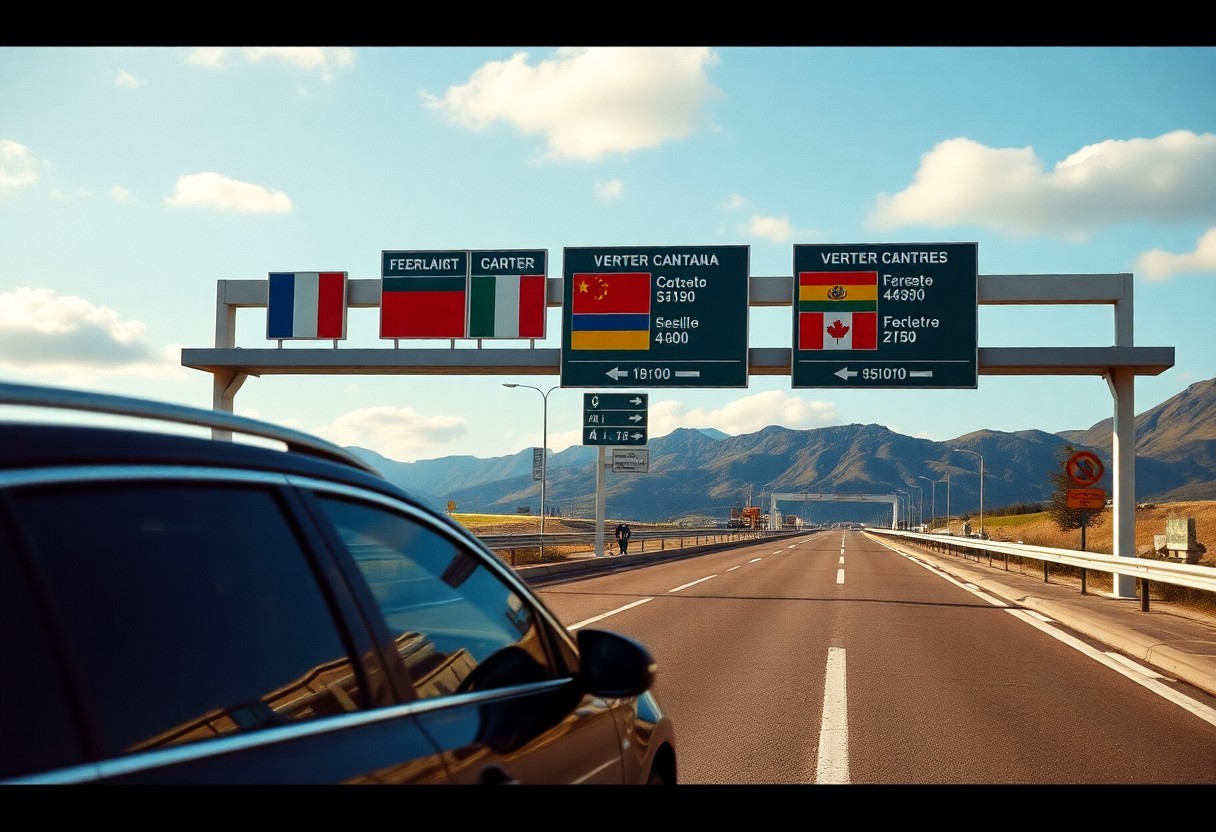Planning for overseas travel in Europe with a rental car is essential for ensuring a seamless and enjoyable journey. This process involves meticulous route planning and a comprehensive understanding of cross-border regulations. Different rental companies have varying policies regarding driving between European countries. While most companies permit travel within Western European nations, restrictions are frequently placed on travel to Eastern European countries. It’s vital to review your rental agreement thoroughly, as it will specify the exact borders you are allowed to cross and any additional fees that might apply. Before booking, confirm that your selected rental company permits travel to all your desired destinations, as violating cross-border regulations can void your insurance coverage and lead to significant penalties. Therefore, gathering clear information about these limitations is crucial for your European road trip.
Navigate the Essential Legal Requirements for Cross-Border Driving
Before you set off on your adventure across Europe with a rental car, you must fulfill specific legal and rental company requirements. Your rental agreement must clearly state that cross-border travel is permissible, and you should ensure you have valid insurance coverage for all the countries you plan to explore. Many rental companies impose restrictions based on specific European zones, and these regulations tend to be more stringent for luxury vehicles. Therefore, it is imperative to familiarize yourself with these requirements to prevent complications during your travels and ensure compliance with local laws.
Secure Your International Driving Permit (IDP) for Legal Driving in Europe
One of the most crucial documents you need for driving in Europe is an International Driving Permit (IDP). Obtaining this permit should be a priority and must be done in your home country before your travel plans begin. The IDP serves as a translation of your regular driver’s license and is legally required in numerous European countries. By securing your IDP in advance, you can ensure compliance with local laws and enjoy a smoother driving experience across various nations, avoiding potential fines or complications.
Gain Insight into Mileage Policies and General Restrictions
When renting a car in Europe, many rental locations provide vehicles with unlimited mileage options, which can be a considerable advantage for travelers seeking to explore extensively. However, it’s essential to recognize that border crossing fees apply, which can vary significantly, typically ranging from €5 to €47.60 per crossing, depending on the rental company and the specific countries involved. Additionally, due to insurance and security protocols, rental companies frequently impose specific restrictions for various vehicle categories. High-end brands such as BMW, Mercedes, and Audi often have more limited travel zones compared to standard models, emphasizing the necessity to declare your travel plans in advance to avoid unexpected charges and ensure a hassle-free experience.

Comprehend the Cross-Border Policies of Major Rental Companies
When renting a car in Europe, it’s imperative to recognize that each rental company has distinct cross-border policies. Major rental companies typically allow travel between Western European countries; however, you will notice that strict restrictions apply for Eastern Europe. The policies can vary considerably based on the type of vehicle, with luxury cars often facing more limitations compared to standard vehicles. Understanding these policies beforehand will empower you to make informed decisions about your rental choices and travel plans, ultimately enhancing your overall experience.
Explore Cross-Border Regulations from Avis and Enterprise
Avis and Enterprise are two rental companies that provide extensive coverage across Western Europe. Their vehicles can generally be driven in most EU countries, including popular destinations like France, Germany, and Spain. Nonetheless, it’s crucial to be aware that both companies impose specific restrictions on luxury vehicles, particularly when entering Italy. For example, Enterprise charges a daily cross-border fee of 5 euros, with a maximum total charge of 50 euros. Familiarizing yourself with these fees in advance will aid in budgeting effectively for your travels, ensuring you avoid any financial surprises.
Understand Cross-Border Driving Policies of AutoEurope and Hertz
Among the prominent rental providers, AutoEurope and Hertz enforce specific country restrictions that are essential for travelers to comprehend. For instance, taking their vehicles into Eastern European nations such as Albania, Belarus, or Ukraine is strictly prohibited. Moreover, Hertz restricts luxury vehicles and SUVs from entering Italy, while AutoEurope’s policies may vary based on their local partners. Therefore, it is critical to declare your travel plans to your chosen provider prior to booking your rental car. Your rental agreement will detail the applicable cross-border fees, which differ by company and destination. For instance, Hertz charges 47.60 euros for crossing from Germany to another approved country, and you will likely need additional insurance coverage for international travel to protect yourself from unforeseen issues.
Stay Informed About Geographical Restrictions to Avoid Issues
The regulations regarding cross-border travel with rental cars in Europe can differ widely based on the rental company and the type of vehicle you select. Your rental agreement will explicitly outline which countries you are permitted to visit with your rental car. It is essential to keep your rental company informed of your planned route, as crossing borders without proper authorization can void your insurance and lead to significant penalties, complicating your travel experience and potentially incurring additional costs.
Identify the Countries You Are Allowed to Drive In
Most rental companies permit you to drive freely within Western European countries, including France, Germany, and Spain. Zone 1 countries typically encompass EU member states in Western Europe, providing the most flexibility for your rental car usage. Your rental agreement will detail all the permitted countries specific to your vehicle class, ensuring you have a clear understanding of where you can travel without issues, thus allowing you to plan your itinerary effectively and enjoy your journey.
Understand and Navigate Restricted Territories to Avoid Fees
Countries behind the Iron Curtain are often subject to restrictions. Most rental companies prohibit travel to Eastern European countries, including Albania, Belarus, Ukraine, and Russia, due to heightened risks and insurance complications. Additionally, further limitations may apply to luxury vehicles and specific car brands. High-end vehicles like BMW, Mercedes, and other premium models often have stricter geographical limits. If your travel plans involve multiple countries, it is advisable to select a standard vehicle class to maximize flexibility and minimize potential fees or insurance complications that could detract from your travel experience.
Examine Vehicle-Specific Limitations for Rental Cars
While rental companies may have varying policies, most enforce strict regulations regarding which vehicles can cross borders. Therefore, it is crucial to check the specific limitations associated with your chosen vehicle class before making a reservation. These restrictions are designed to protect valuable assets and ensure compliance with insurance requirements across different European territories, helping to prevent potential disputes during your journey.
Maximize Flexibility with Standard Rental Cars for Cross-Border Travel
Contrary to common misunderstandings, standard rental cars actually provide the greatest flexibility for cross-border travel. You can typically drive standard vehicles in most Western European countries without needing special permits or facing significant restrictions. However, it is essential to inform your rental company about your travel intentions, as you may need to pay cross-border fees ranging from 5 to 50 euros depending on the situation and the countries involved in your itinerary.
Recognize Restrictions on Luxury Vehicles for Cross-Border Travel
Significant restrictions apply to high-end vehicles in the context of cross-border travel. Luxury cars face notable limitations on border crossings, with brands such as BMW, Mercedes, and Audi often prohibited from entering Eastern European countries or Italy. Generally, these luxury vehicles are confined to Zone 1 countries within Western Europe, limiting your travel options and necessitating careful planning.
Furthermore, if you plan to rent luxury vehicles, anticipate higher security deposits and stricter insurance requirements. Rental companies like Sixt and Enterprise impose limitations on premium brands like Jaguar, Maserati, and Porsche, allowing them only in select Western European countries. For any border crossings, you will require special permission and potentially additional insurance coverage, so be proactive in understanding the terms before your rental.
Plan Your Budget for Border Crossing Costs Effectively
It’s essential to keep your budget in mind when planning any cross-border trips in Europe with a rental car. Most rental companies impose additional fees for crossing borders, even within the Schengen Area. It’s crucial to inform your rental company about your intended route and obtain written permission prior to crossing any borders to avoid unexpected charges that can impact your travel plans and financial situation.
Anticipate Typical Fees for Border Crossings to Budget Wisely
Border crossing fees in Europe typically range from €5 to €50, depending on the rental company and specific circumstances. For example, you’ll incur €47.60 with Hertz when crossing from Germany to another allowed country, while Enterprise charges €5 per day, capping at €50 for trips starting in Germany. Being aware of these fees will significantly aid in your financial planning during your travels, allowing you to allocate funds appropriately for your journey.
Consider Potential Additional Charges for Comprehensive Planning
At certain borders, you may face extra insurance requirements and documentation fees. Your rental company might charge for special permits, particularly when traveling to Eastern European countries or when using luxury vehicles. Additionally, you should account for the likelihood of higher insurance premiums for specific destinations, especially in Italy or Eastern Europe. Remember that some credit card insurance policies may not cover all European countries, necessitating the purchase of additional coverage from your rental company to ensure peace of mind during your travels.

Master the Art of Navigating Ferry Travel with Your Rental Car
Not all rental companies have the same policies regarding ferry travel in Europe. While most companies permit ferry travel, it’s essential to verify the specific rules associated with your rental. Crossing water borders often requires additional documentation and may incur extra fees that you need to be prepared for. Moreover, your insurance coverage might change when traveling by ferry, making it vital to understand these aspects to avoid complications during your journey.
Understand Company-Specific Ferry Policies for Smooth Travel
Among notable rental companies, policies regarding ferry travel can vary considerably. Avis and Hertz typically allow ferry travel to approved countries, but it is essential to verify destination restrictions beforehand to avoid complications later. In contrast, Enterprise and Sixt may require pre-authorization and additional insurance for ferry crossings, which should be clearly stated in your rental agreement to prevent misunderstandings that could disrupt your travel plans.
Account for Important Considerations Regarding Breakdown Coverage
Another crucial factor to consider is vehicle breakdown coverage in the event of ferry travel. Most rental companies hold you accountable for vehicle repatriation costs if your car breaks down after a ferry crossing, which can amount to several thousand euros, depending on your location and the type of vehicle being rented. This responsibility extends beyond mechanical failures; if you have an accident or the vehicle becomes unusable for any reason while on an island, you are liable for the costs required to return the vehicle to the original rental location. Some rental companies offer additional insurance to cover these expenses, but it is critical to purchase it before your journey to ensure you are adequately protected against unforeseen incidents.
Strategically Conclude Your Journey with Cross-Border Driving Insights
When planning to drive a rental car across European borders, thorough research and understanding of specific rules with your rental company are essential. You may have the freedom to cross borders in most European countries, but keep in mind that each rental company has its own policies and fees that you need to be aware of. The type of rental vehicle you choose can significantly affect where you are allowed to travel, with luxury cars often facing more restrictions than standard models. Always confirm the countries you are allowed to visit, account for any required border crossing fees, and check the ferry travel regulations before embarking on your trip. Reading the rental agreement closely and obtaining an International Driving Permit will further prepare you for a smooth journey. Your advance planning is vital for avoiding complications at border crossings, ensuring a more enjoyable travel experience.
Your Guide to Frequently Asked Questions About Driving Rental Cars in Europe
Can I drive my rental car to any European country without restrictions?
No, rental companies maintain specific regulations regarding the countries you can visit. Most companies permit travel within Western European nations such as France, Germany, and Spain. However, many impose restrictions on travel to Eastern European countries including Albania, Belarus, and Ukraine. Luxury vehicles often have more stringent limitations. Always check your rental agreement for allowed countries prior to any border crossings to ensure compliance and avoid penalties.
Are there additional fees for crossing borders with a rental car in Europe?
Yes, many rental companies impose border crossing fees. For example, Hertz charges 47.60 euros for each border crossing from Germany, while Enterprise charges 5 euros per day (with a maximum of 50 euros) for trips originating in Germany. These fees apply even when traveling within the Schengen Area. It is crucial to inform the rental company about your travel itinerary and settle these fees before crossing any borders to ensure a hassle-free journey.
Can I take my rental car on a ferry between European countries without issues?
Yes, most rental companies allow ferry travel if your destination country is included on their approved list. However, if your vehicle breaks down while on an island, you will be responsible for the costs associated with returning the vehicle to its original rental location. Some companies, such as Hertz, offer coverage for ferry travel through their insurance options (CDW, TP, or SuperCover). Always verify the specific ferry policies stated in your rental agreement to avoid any surprises or complications during your travels.
The Article: Is It Allowed to Drive a Rental Car Across European Borders? appeared first on https://rentacar24.org/
The Article Driving a Rental Car Across European Borders: Is It Allowed? Was Found On https://limitsofstrategy.com



Comments are closed